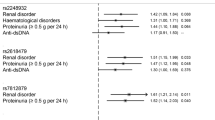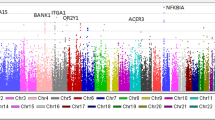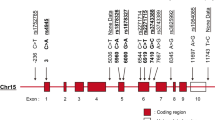Abstract
The ATP-binding cassette transporter (TAP) proteins are functionally relevant candidates for predisposition to systemic lupus erythematosus (SLE) by virtue of their role in autoantigen presentation and location in the major histocompatibility complex (MHC). We tested if variation in the TAP genes (TAP1 and TAP2) is associated with SLE. We genotyped tag single nucleotide polymorphisms (SNPs) and performed family-based association analysis on 390 Caucasian pedigrees. We found significant evidence of association between TAP2 and SLE (rs241453, P=1.33 × 10−6). Conditional logistic regression analysis suggests that this TAP2 effect is separate from the HLA-DRB1 alleles. Our analyses show that both rs241453 (P=1.6 × 10−4) and HLA-DRB1*03xx (P=2.3 × 10−4) have significant autonomous effects not due to linkage disequilibrium. Moreover, these loci exhibit a significant statistical interaction (P<1.0 × 10−6), demonstrated by an increase in the odds ratio for the TAP2 association from OR=2.00 (95% confidence interval (CI)=1.17–3.42) in HLA-DRB1*03xx-negative subjects to OR=4.29 (CI=1.88–9.76) in the subjects with at least one HLA-DRB1*03xx allele group. We report the largest association study of the TAP genes with SLE to date, and the first to test for its separate effect and interaction with the HLA alleles consistently associated with SLE.
This is a preview of subscription content, access via your institution
Access options
Subscribe to this journal
Receive 6 digital issues and online access to articles
$119.00 per year
only $19.83 per issue
Buy this article
- Purchase on Springer Link
- Instant access to full article PDF
Prices may be subject to local taxes which are calculated during checkout

Similar content being viewed by others
References
Helmick CG, Felson DT, Lawrence RC, Gabriel S, Hirsch R, Kwoh CK et al. Estimates of the prevalence of arthritis and other rheumatic conditions in the United States. Part I. Arthritis Rheum 2008; 58: 15–25.
Harley JB, Alarcon-Riquelme ME, Criswell LA, Jacob CO, Kimberly RP, Moser KL et al. Genome-wide association scan in women with systemic lupus erythematosus identifies susceptibility variants in ITGAM, PXK, KIAA1542 and other loci. Nat Genet 2008; 40: 204–210.
Graham RR, Ortmann WA, Langefeld CD, Jawaheer D, Selby SA, Rodine PR et al. Visualizing human leukocyte antigen class II risk haplotypes in human systemic lupus erythematosus. Am J Hum Genet 2002; 71: 543–553.
Huang AY, Bruce AT, Pardoll DM, Levitsky HI . In vivo cross-priming of MHC class I-restricted antigens requires the TAP transporter. Immunity 1996; 4: 349–355.
Malnati MS, Marti M, LaVaute T, Jaraquemada D, Biddison W, DeMars R et al. Processing pathways for presentation of cytosolic antigen to MHC class II-restricted T cells. Nature 1992; 357: 702–704.
Kageyama G, Kawano S, Kanagawa S, Kondo S, Sugita M, Nakanishi T et al. Effect of mutated transporters associated with antigen-processing 2 on characteristic major histocompatibility complex binding peptides: analysis using electrospray ionization tandem mass spectrometry. Rapid Commun Mass Spectrom 2004; 18: 995–1000.
Correa PA, Molina JF, Pinto LF, Arcos-Burgos M, Herrera M, Anaya JM . TAP1 and TAP2 polymorphisms analysis in northwestern Colombian patients with systemic lupus erythematosus. Ann Rheum Dis 2003; 62: 363–365.
Davies EJ, Donn RP, Hillarby MC, Grennan DM, Ollier WE . Polymorphisms of the TAP2 transporter gene in systemic lupus erythematosus. Ann Rheum Dis 1994; 53: 61–63.
Kanagawa S, Morinobu A, Koshiba M, Kageyama G, Hayashi N, Yoshino S et al. Association of the TAP2*Bky2 allele with presence of SS-A/Ro and other autoantibodies in Japanese patients with systemic lupus erythematosus. Lupus 2003; 12: 258–265.
Martin-Villa JM, Martinez-Laso J, Moreno-Pelayo MA, Castro-Panete MJ, Martinez-Quiles N, Alvarez M et al. Differential contribution of HLA-DR, DQ, and TAP2 alleles to systemic lupus erythematosus susceptibility in Spanish patients: role of TAP2*01 alleles in Ro autoantibody production. Ann Rheum Dis 1998; 57: 214–219.
Takeuchi F, Nakano K, Nabeta H, Hong GH, Kuwata S, Ito K . Polymorphisms of the TAP1 and TAP2 transporter genes in Japanese SLE. Ann Rheum Dis 1996; 55: 924–926.
de Bakker PI, McVean G, Sabeti PC, Miretti MM, Green T, Marchini J et al. A high-resolution HLA and SNP haplotype map for disease association studies in the extended human MHC. Nat Genet 2006; 38: 1166–1172.
Alvarado-Guerri R, Cabrera CM, Garrido F, Lopez-Nevot MA . TAP1 and TAP2 polymorphisms and their linkage disequilibrium with HLA-DR, -DP, and -DQ in an eastern Andalusian population. Hum Immunol 2005; 66: 921–930.
Lee HS, Lee AT, Criswell LA, Seldin MF, Amos CI, Carulli JP et al. Several regions in the major histocompatibility complex confer risk for anti-CCP-antibody positive rheumatoid arthritis, independent of the DRB1 locus. Mol Med 2008; 14: 293–300.
Cullen M, Perfetto SP, Klitz W, Nelson G, Carrington M . High-resolution patterns of meiotic recombination across the human major histocompatibility complex. Am J Hum Genet 2002; 71: 759–776.
Miretti MM, Walsh EC, Ke X, Delgado M, Griffiths M, Hunt S et al. A high-resolution linkage-disequilibrium map of the human major histocompatibility complex and first generation of tag single-nucleotide polymorphisms. Am J Hum Genet 2005; 76: 634–646.
Parks CG, Pandey JP, Dooley MA, Treadwell EL, St Clair EW, Gilkeson GS et al. Genetic polymorphisms in tumor necrosis factor (TNF)-alpha and TNF-beta in a population-based study of systemic lupus erythematosus: associations and interaction with the interleukin-1alpha-889 C/T polymorphism. Hum Immunol 2004; 65: 622–631.
Gaffney PM, Kearns GM, Shark KB, Ortmann WA, Selby SA, Malmgren ML et al. A genome-wide search for susceptibility genes in human systemic lupus erythematosus sib-pair families. Proc Natl Acad Sci USA 1998; 95: 14875–14879.
Gray-McGuire C, Moser KL, Gaffney PM, Kelly J, Yu H, Olson JM et al. Genome scan of human systemic lupus erythematosus by regression modeling: evidence of linkage and epistasis at 4p16-15.2. Am J Hum Genet 2000; 67: 1460–1469.
Hochberg MC . Updating the American College of Rheumatology revised criteria for the classification of systemic lupus erythematosus. Arthritis Rheum 1997; 40: 1725.
de Bakker PI, Yelensky R, Pe'er I, Gabriel SB, Daly MJ, Altshuler D . Efficiency and power in genetic association studies. Nat Genet 2005; 37: 1217–1223.
O'Connell JR, Weeks DE . PedCheck: a program for identification of genotype incompatibilities in linkage analysis. Am J Hum Genet 1998; 63: 259–266.
Bugawan TL, Apple R, Erlich HA . A method for typing polymorphism at the HLA-A locus using PCR amplification and immobilized oligonucleotide probes. Tissue Antigens 1994; 44: 137–147.
Erlich H, Valdes AM, Noble J, Carlson JA, Varney M, Concannon P et al. HLA DR-DQ haplotypes and genotypes and type 1 diabetes risk: analysis of the type 1 diabetes genetics consortium families. Diabetes 2008; 57: 1084–1092.
Helmberg W, Lanzer G, Zahn R, Weinmayr B, Wagner T, Albert E . Virtual DNA analysis--a new tool for combination and standardised evaluation of SSO, SSP and sequencing-based typing results. Tissue Antigens 1998; 51: 587–592.
Barrett JC, Fry B, Maller J, Daly MJ . Haploview: analysis and visualization of LD and haplotype maps. Bioinformatics 2005; 21: 263–265.
Dudbridge F . Pedigree disequilibrium tests for multilocus haplotypes. Genet Epidemiol 2003; 25: 115–121.
Harley JB, Moser KL, Neas BR . Logistic transmission modeling of simulated data. Genet Epidemiol 1995; 12: 607–612.
Acknowledgements
We thank the families and their referring physicians for their participation in this study. We are grateful for the support of Lindsey A Criswell and Lisa F Barcellos. We acknowledge Julie A Lane for generating the HLA-DRB1 genotyping results, and Lingyi Lu and Miranda Marion for assistance with programming. This research was supported by NIH/NIAMS R01 AR043274 (KLM), R01 AR052300 (LAC, LFB), Lupus Foundation of Minnesota (KLM) and the Center for Public Health Genomics at Wake Forest University Health Sciences (CDL).
Author information
Authors and Affiliations
Corresponding author
Rights and permissions
About this article
Cite this article
Ramos, P., Langefeld, C., Bera, L. et al. Variation in the ATP-binding cassette transporter 2 gene is a separate risk factor for systemic lupus erythematosus within the MHC. Genes Immun 10, 350–355 (2009). https://doi.org/10.1038/gene.2009.21
Received:
Revised:
Accepted:
Published:
Issue Date:
DOI: https://doi.org/10.1038/gene.2009.21
Keywords
This article is cited by
-
Association between TAP gene polymorphisms and tuberculosis susceptibility in a Han Chinese population in Guangdong
Molecular Genetics and Genomics (2022)
-
Genetic association analysis of TAP1 and TAP2 polymorphisms with aspirin exacerbated respiratory disease and its FEV1 decline
Journal of Human Genetics (2011)



